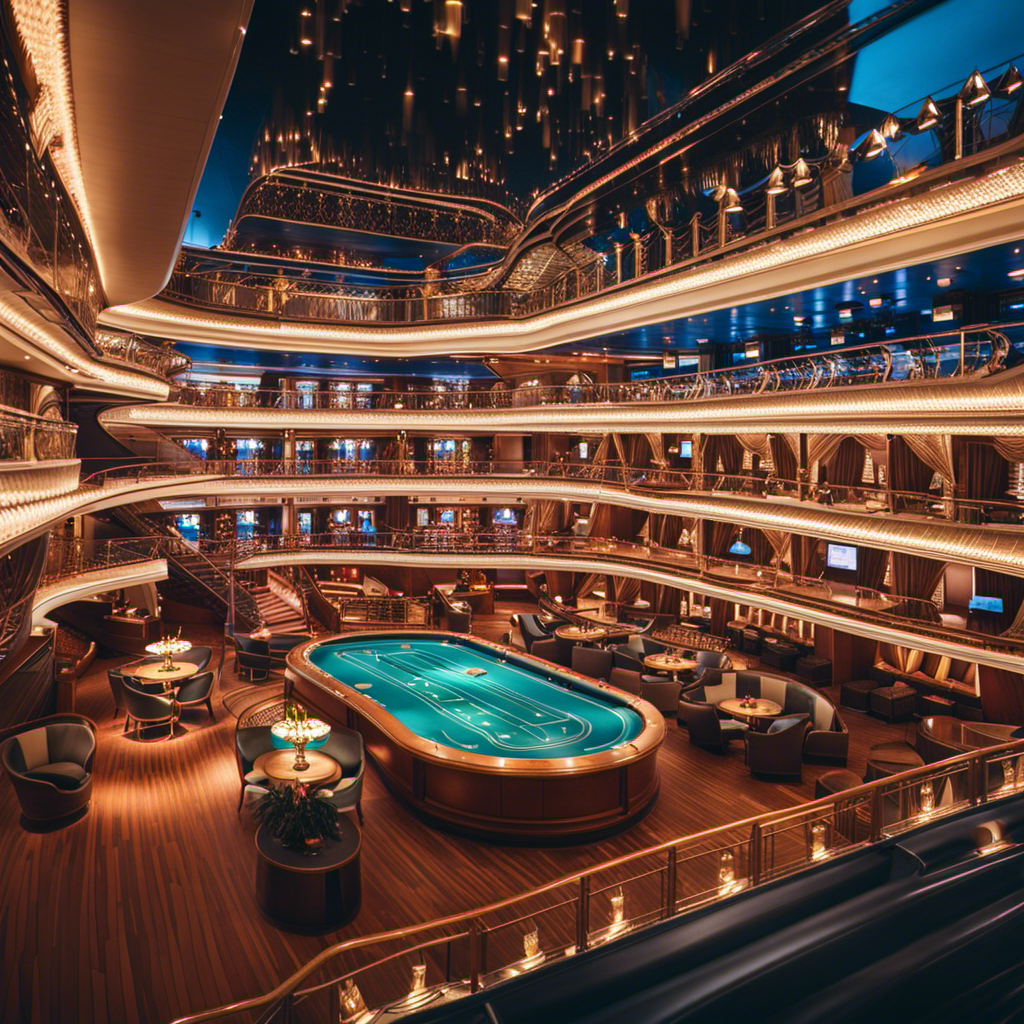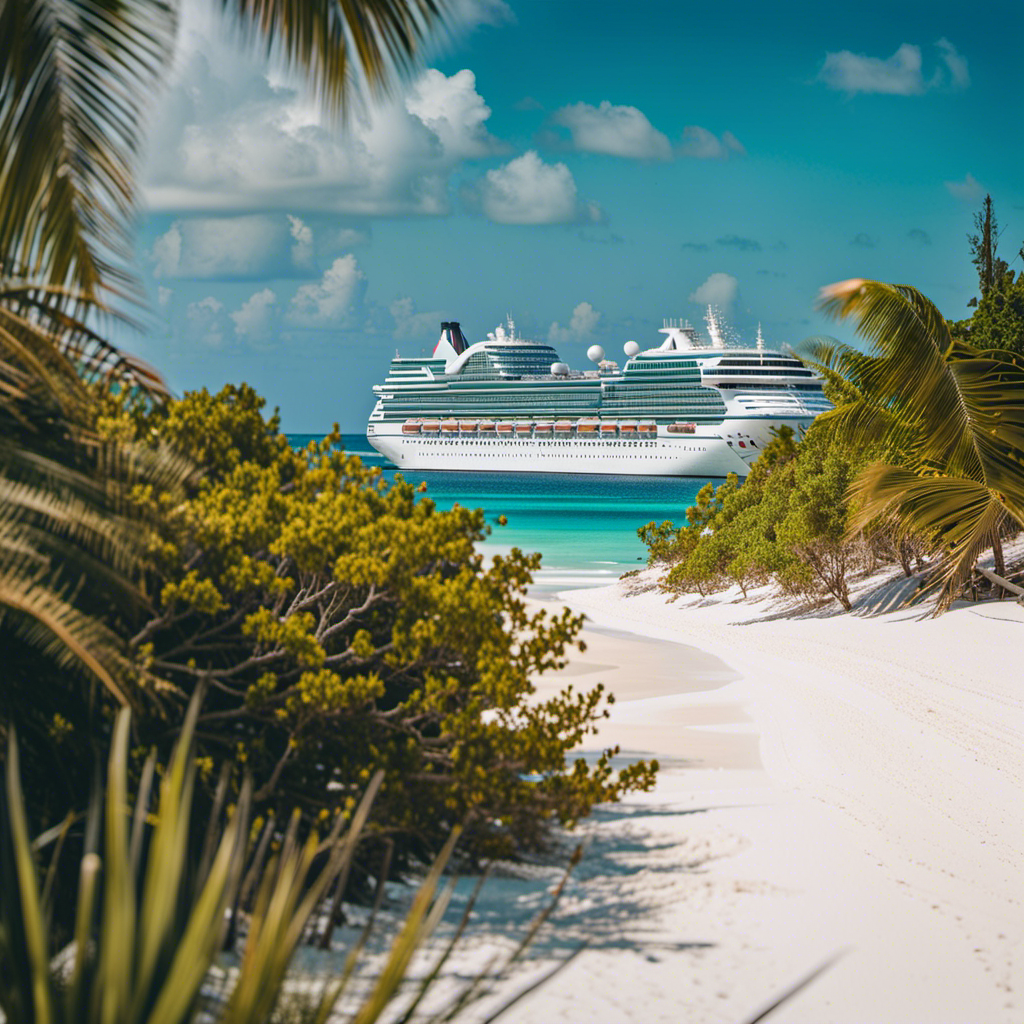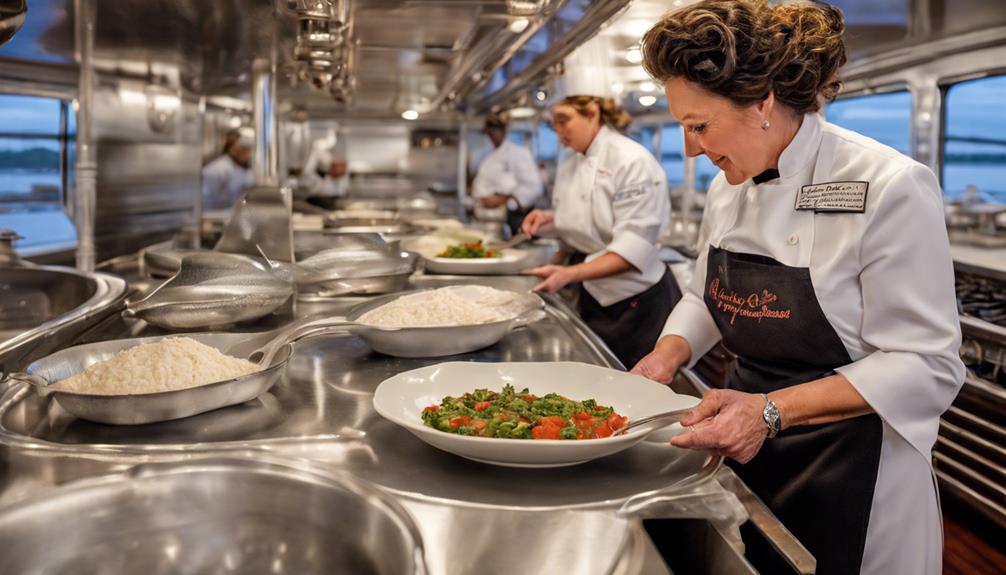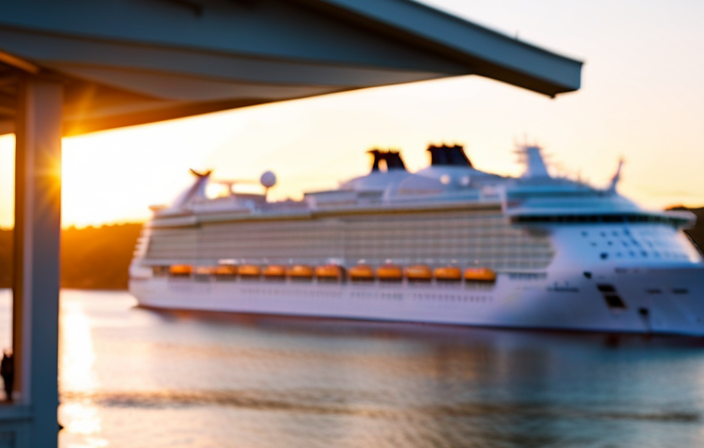As someone who is always fascinated by the workings of the travel industry, I often wonder about the financial benefits that cruise ships achieve. Join me on an exploration where we will delve into a data-driven analysis, looking at the revenue streams, profit margins, and factors affecting the financial performance of these massive sea-based sanctuaries.
We’ll analyze the role of ticket sales, onboard spending, and the importance of repeat customers. Get ready to dive deep into the financial performance and trends of the cruise industry, comparing the earnings of different cruise lines along the way.
Key Takeaways
- Multiple revenue sources, including ticket sales, onboard purchases, and onboard activities, contribute to cruise ship earnings.
- Market demand, competition, operational costs, and investments are factors that influence cruise ship profitability.
- Operational efficiency, cost reduction strategies, and strategic investments are important for maximizing profits.
- Ticket pricing, onboard spending, and repeat customers play a significant role in determining cruise ship profits.
Revenue Streams of Cruise Ships
Cruise ships make money through a variety of revenue streams, ensuring revenue diversification and maximizing their earnings. One significant source of income for cruise ships is ticket sales. Passengers purchase tickets for their cruise vacations, generating a substantial portion of the cruise line’s revenue.
However, cruise ships also rely on ancillary income to boost their earnings. This includes revenue from onboard purchases such as food, beverages, and retail products. Additionally, cruise lines generate income through various onboard activities and services, like casinos, spa treatments, and shore excursions.
These revenue streams allow cruise ships to not only cover their operational costs but also generate profits. Transitioning into the next section about profit margins in the cruise industry, it is essential to understand how these revenue diversification strategies impact the overall financial performance of cruise ships.
Profit Margins in the Cruise Industry
Investing in the cruise industry can be a profitable venture due to the high profit margins. The profitability analysis of the cruise industry reveals several revenue sources that contribute to these margins.
-
Ticket Sales: The primary source of revenue for cruise ships is ticket sales. With increasing demand for cruise vacations, companies can charge premium prices, resulting in significant profits.
-
Onboard Expenditure: Cruise ship passengers spend on various onboard amenities, including dining, entertainment, and shopping. This additional revenue stream adds to the overall profitability.
-
Excursions and Shore Activities: Cruise lines offer excursions and shore activities to enhance the passenger experience. These activities generate additional revenue, contributing to the profit margins.
Considering these revenue sources, it is evident that the cruise industry has multiple avenues for generating profits. Factors such as passenger demand, customer satisfaction, and effective cost management influence cruise ship earnings.
Factors Influencing Cruise Ship Earnings
Market demand and competition are key factors that significantly influence cruise ship earnings. Understanding market demand and competition is essential for cruise companies to strategically position themselves in the industry and attract customers.
Operational costs and investments play a crucial role in determining the profitability of cruise ships. They directly impact the overall expenses and revenue generation.
Therefore, analyzing these factors is vital for cruise companies to make informed decisions and optimize their earnings.
Market Demand and Competition
Due to high demand and intense competition, it’s crucial for cruise ship companies to continually innovate and offer unique experiences to attract customers. The cruise ship market has experienced significant growth over the years, with more people opting for this type of vacation.
According to industry reports, the global cruise market is expected to reach a value of $57 billion by 2027, growing at a CAGR of 5.1%. To capitalize on this market growth, cruise ship companies employ various pricing strategies to entice customers and maximize revenue. These strategies include offering early bird discounts, loyalty programs, and package deals.
Operational Costs and Investments
To maintain a profitable business model, cruise ship companies need to carefully analyze their operational costs and make strategic investments.
Operational efficiency is crucial in reducing costs and maximizing profits. By implementing cost reduction strategies, such as optimizing fuel consumption, improving maintenance practices, and streamlining onboard operations, cruise ship companies can significantly improve their bottom line. These strategies not only help in reducing expenses but also enhance overall operational efficiency.
For example, investing in new technologies and systems that automate certain processes can lead to significant cost savings. By leveraging data analytics and industry insights, cruise ship companies can identify areas where they can improve efficiency and reduce costs. This enables them to allocate resources more effectively and ensure the long-term sustainability of their business.
As we delve further into the topic of cruise ship revenue, it is important to consider the role of ticket sales in generating income.
The Role of Ticket Sales in Cruise Ship Revenue
Ticket sales play a significant role in how much money cruise ships make. The pricing of tickets is a crucial factor in determining the revenue generated by these floating resorts. Here are three key points to consider:
-
Ticket Pricing: Cruise lines carefully calculate ticket prices to maximize their profits. They conduct extensive market research to understand customer demand and set prices accordingly. Factors such as the destination, duration, amenities, and seasonality all influence ticket pricing.
-
Customer Demographics: Cruise ships cater to a wide range of demographics, including families, couples, and solo travelers. Understanding the preferences and purchasing power of these different customer segments helps cruise lines determine the most profitable ticket options for each group.
-
Upselling Opportunities: Once onboard, cruise lines capitalize on various opportunities to increase revenue through onboard spending. This includes offering specialty dining, spa treatments, excursions, and premium beverage packages.
Onboard Spending and Cruise Ship Profits
In my analysis of cruise ship revenue, I have found that onboard spending plays a crucial role in determining cruise ship profits. The trends in onboard spending have shown a significant impact on the financial success of cruise ships.
Passengers now have a plethora of activities and amenities to choose from while on board, ranging from specialty dining options to spa treatments and excursions. This has led to a substantial increase in onboard spending, as passengers are willing to pay for these additional experiences.
The impact of onboard activities on cruise ship profits cannot be overstated. The revenue generated from onboard spending often surpasses ticket sales. Cruise lines have recognized this trend and have responded by continuously expanding and enhancing onboard offerings to entice passengers to spend more.
By providing a variety of activities, cruise ships are able to maximize their profits and create a more enjoyable experience for their guests.
As we delve into the importance of repeat customers for cruise ships, it becomes clear how onboard spending contributes to customer satisfaction and loyalty.
The Importance of Repeat Customers for Cruise Ships
When you choose to cruise with the same company multiple times, you benefit from exclusive perks and rewards that enhance your overall experience. This is known as the loyalty effect, and it is a key strategy for cruise ship companies to increase customer retention.
Here are three reasons why repeat customers are important for cruise ships:
-
Increased Revenue: Repeat customers tend to spend more money on onboard amenities, such as specialty dining, spa services, and excursions. This boosts the cruise ship’s profits and overall revenue.
-
Positive Word-of-Mouth: Satisfied repeat customers are more likely to recommend the cruise line to their friends and family, leading to new customers and higher bookings.
-
Lower Marketing Costs: Retaining existing customers is more cost-effective than acquiring new ones. By focusing on customer retention strategies, cruise ships can reduce their marketing expenses and allocate resources towards enhancing the onboard experience.
Understanding the importance of repeat customers helps cruise ship companies develop effective customer retention strategies.
Now, let’s delve into the next section and explore the fascinating world of understanding cruise ship operating costs.
Understanding Cruise Ship Operating Costs
Understanding the expenses involved in operating a cruise ship is crucial for companies to effectively manage their costs and maximize profitability. One major area of expenditure for cruise ship operators is maintenance expenses. Cruise ships require regular maintenance to ensure they are safe and in good working condition. This includes routine inspections, repairs, and upgrades to various systems and facilities onboard. These maintenance costs can be significant and can vary depending on the age, size, and complexity of the ship.
Another significant factor impacting operating costs is fuel prices. Fuel expenses can make up a substantial portion of a cruise ship’s operating budget. Fluctuations in fuel prices can have a direct impact on the overall profitability of a cruise ship company. When fuel prices rise, it increases the cost of operating the ship, which can eat into the company’s profits. On the other hand, when fuel prices decrease, it can lead to higher profitability for the company.
Understanding these factors and effectively managing cruise ship maintenance expenses and fuel costs is essential for cruise ship companies to maintain a healthy financial performance. By analyzing data on maintenance expenses and closely monitoring fuel prices, companies can make informed decisions to optimize their operating costs and improve their overall financial performance.
This transition into the subsequent section about cruise ship financial performance: trends and analysis allows for a seamless flow of information, without using the word "step".
Cruise Ship Financial Performance: Trends and Analysis
To effectively analyze trends and assess the financial performance of cruise ship companies, you need to closely examine key indicators such as revenue growth, operating margins, and return on investment.
When looking at the cruise ship industry outlook, it is important to consider the future growth prospects. In recent years, the cruise ship industry has experienced significant growth, with increasing numbers of passengers and new ship launches. This growth has translated into higher revenues for cruise ship companies. Operating margins have also improved, indicating better cost management and operational efficiency. Return on investment, a crucial measure of profitability, has shown positive trends as well.
These indicators suggest that the cruise ship industry is thriving and holds promising future growth prospects.
As we delve further into comparing the earnings of different cruise lines, it becomes evident how these financial indicators play a significant role in determining the success of each company.
Comparing the Earnings of Different Cruise Lines
When examining the financial performance of cruise lines, it becomes apparent that their profits vary significantly.
There are several factors that influence the earnings of these companies, including ticket prices, occupancy rates, onboard spending, and operational costs.
Varying Cruise Line Profits
Different cruise lines have varying profits. In order to understand the profitability of each cruise line, a thorough profitability analysis is necessary. This analysis takes into account various factors such as revenue growth, operating costs, and market share.
The cruise industry has experienced steady revenue growth over the years, with an increasing number of people opting for cruise vacations. However, the profitability of individual cruise lines can differ significantly. Factors such as brand reputation, customer satisfaction, and operational efficiency play a crucial role in determining the profitability of a cruise line.
Additionally, external factors such as global economic conditions and fuel prices can also impact earnings. By examining these factors, we can gain insights into the factors impacting earnings without delving into the subsequent section.
Factors Impacting Earnings
In order to understand the varying profits of cruise lines, it is essential to examine the factors that affect their profitability.
Several key elements come into play, each with its own economic impact.
Firstly, the cost of fuel is a significant factor. As fuel prices fluctuate, it directly impacts the operational expenses of cruise ships, which can subsequently affect their profitability.
Secondly, the demand for cruises plays a crucial role. Economic factors such as disposable income, consumer confidence, and global economic conditions all influence the demand for cruise vacations.
Additionally, competition within the industry can impact profitability. Cruise lines must constantly differentiate themselves and offer unique experiences to attract and retain customers.
Finally, external factors such as natural disasters, geopolitical events, and global health crises can have a profound impact on the profitability of cruise lines.
Frequently Asked Questions
How Does the Size of a Cruise Ship Affect Its Revenue?
The size of a cruise ship has a direct correlation to its revenue. Larger ships can accommodate more passengers, leading to higher ticket sales and onboard spending. This economic impact contributes significantly to the overall profitability of the cruise industry.
What Is the Average Cost of Building a New Cruise Ship?
The average cost of building a new cruise ship can vary depending on factors such as size, amenities, and shipyard selection. However, it is important to consider the cost breakdown and carefully analyze industry data to determine an accurate estimate.
How Do Cruise Ships Generate Additional Income Outside of Ticket Sales?
Cruise ships generate additional income through various means, such as selling cruise ship merchandise and offering onboard activities. These revenue streams contribute to their overall financial success and profitability.
What Role Do Travel Agencies Play in the Cruise Ship Industry’s Financial Success?
Travel agencies play a pivotal role in the financial success of the cruise ship industry. They act as the marketing engine, driving bookings through their expertise and connections. Customer reviews greatly impact their ability to attract and retain customers.
How Important Is the Destination or Itinerary in Determining a Cruise Ship’s Profitability?
The destination or itinerary plays a crucial role in determining a cruise ship’s profitability. Customer preferences are key factors in choosing a cruise, and the relevance of the destination greatly influences their decision.
Conclusion
In conclusion, the cruise ship industry is a lucrative business that generates substantial revenue through various streams. From ticket sales to onboard spending, cruise ships have multiple sources of income.
Profit margins in the industry are influenced by factors such as operational costs and customer satisfaction. Repeat customers play a vital role in ensuring the financial success of cruise lines.
By understanding trends, analyzing financial performance, and comparing earnings, cruise companies can make informed decisions to maximize their profits in this competitive industry.










